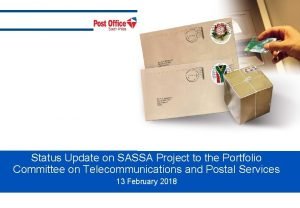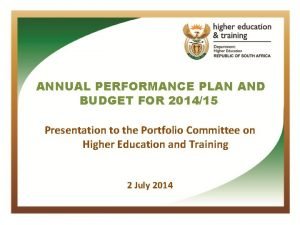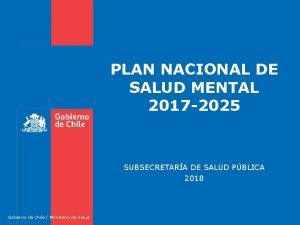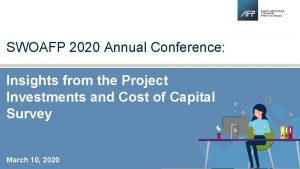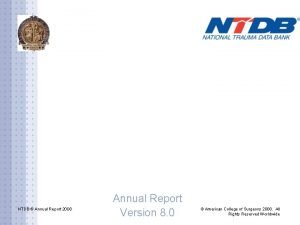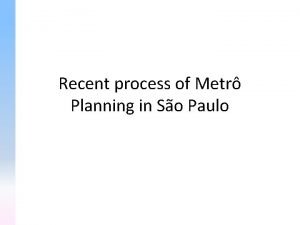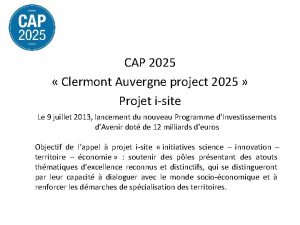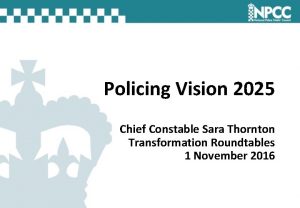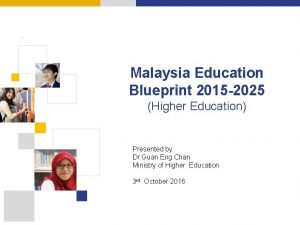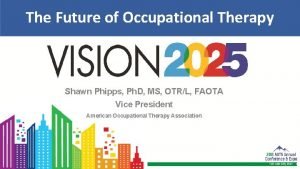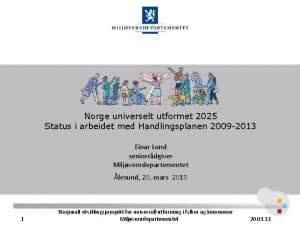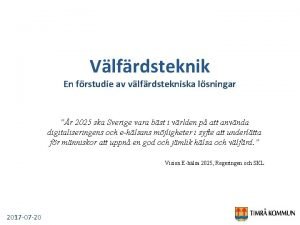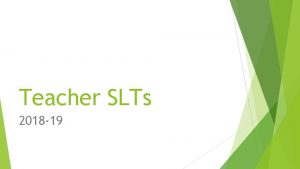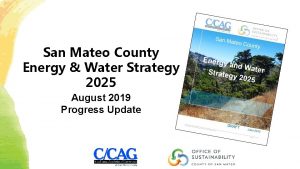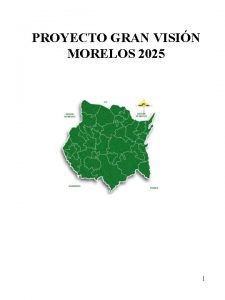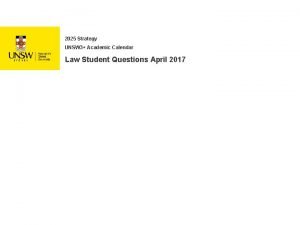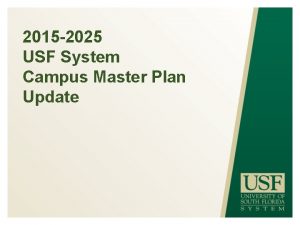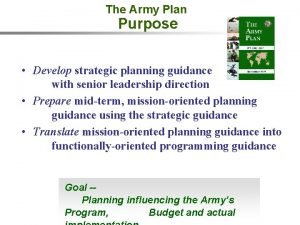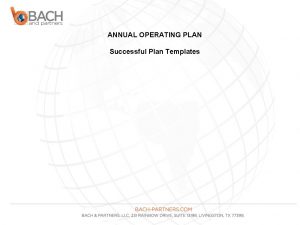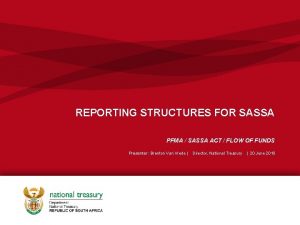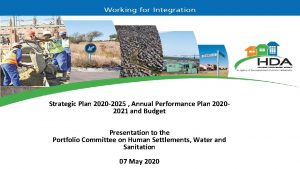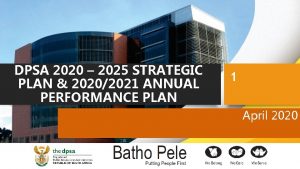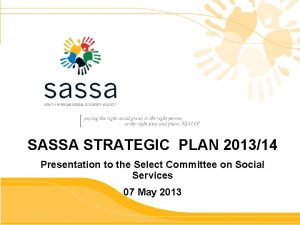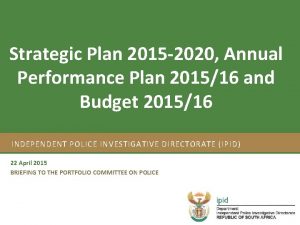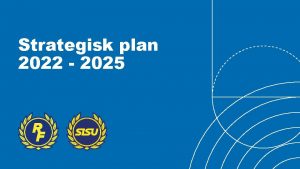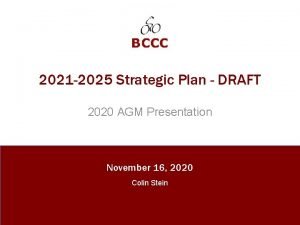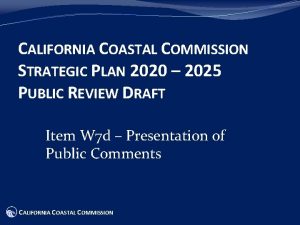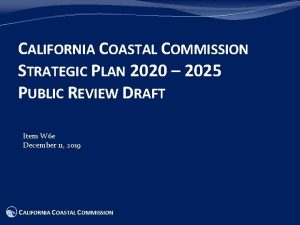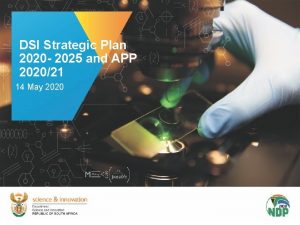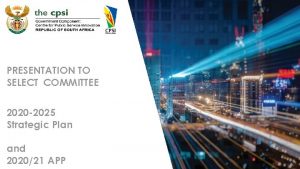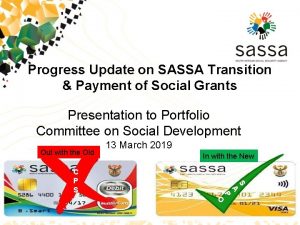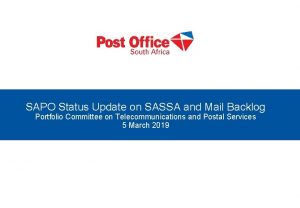SASSA STRATEGIC PLAN 2020 2025 ANNUAL PERFORMANCE PLAN







































- Slides: 39

SASSA STRATEGIC PLAN (2020 -2025), ANNUAL PERFORMANCE PLAN (2020/21) & 2020/21 MTEF BUDGET Presentation to the Portfolio Committee on Social Development

Presentation Outline • Context • SASSA’s Business and Value-Add over the next 5 years • SASSA’s Impact Statement and Outcomes • SASSA’s five year (Strategic Plan) plan and targets • Impact of COVID -19 on SASSA’s plans • Key Organisational Risks • SASSA 2020/21 MTEF Financial Plan • Recommendations 2

Purpose • The purpose of the presentation is to brief the Portfolio Committee on Social Development on: – SASSA’s Strategic (2020 -2025) and Annual Performance (2020/21) Plans; – Impact of Covid-19 of SASSA’s plan – SASSA 2020/21 MTEF budget allocation. 3

OVERVIEW 4

SASSA OPERATIONS • SASSA is agency responsible for efficient and effective management, administration and payment of social assistance • The Social Assistance Act of 2004 provide the legal framework for the provision of social assistance • The social assistance programme and the operations of SASSA are fully funded by government. – Total social assistance transfers: R 187, 835, 779, 000 (The budget has been temporarily adjusted to address Covid-19) – Total administration: R 7 718 421 000 • SASSA’s work is aligned to priority number three “Consolidating the Social Wage through Reliable and Quality Basic Services” of the sixth administration priorities. 5

Vision and mission Vision Mission Values Integrity A leader in the delivery of social security services To provide social security and related services Guiding principles Transparency Compassion Professionalism Customer centric Confidentiality Fairness Courtesy Responsibility Respect Accountability Paying the right social grant, to the right person, at the right time and place 6

Context • The National Development Plan mandates that the country should ensure progressively and through multiple avenues that no one lives below a defined minimum social floor. • This was emphasized in the President State of the Nations Address • The inflation-adjusted national poverty lines for 2019 (per person per month in Rands) – Food poverty line (FPL): – Lower-bound poverty line (LBPL) – Upper-bound poverty line (UBPL) R 561 R 810 R 1 227 • Unemployment Rate in the country stands at 29% of the population (i. e, approximately 15 million for whole population, and 8 million for adults between 18 and 59) • Most of the social grants administered by SASSA are currently above the upperbound poverty line of R 1227 except for the Child Support Grant which R 445 • The objective is to ensure that over the next five years, South African who are unable to support themselves and/or their dependents are supported to be able to live below the minimum poverty line 7

SASSA’s Business and Value-Add over the next 5 years • SASSA is in the business of: – Provision of social assistance to eligible South Africans who are unable to support themselves and their dependents with the goal to alleviate poverty • SASSAs value add: – Contributes to poverty alleviation; – Contributes to individual social well-being; – Provides a safety net to the most vulnerable.

SASSA Impact and Outcomes for the MTSF Period 2020 - 2025 • Impact Statement: – Improved quality of life for vulnerable people and those living in poor conditions • Outcomes: – Reduced levels of poverty (Primary) – Economic transformation – Empowered individuals and sustainable communities; – Improved customer experience; and – Improved organisational efficiencies. 2

FIVE YEAR PLAN LINKED TO OUTCOMES 10

Outcome 1: Reduced levels of poverty • Baseline: – Unemployment Rate in SA stands at 29% of the population (i. e, approximately 15 million for whole population, and 8 million for adults between 18 and 59) – SASSA currently provide Social Assistance to approximately 18. 6 million South Africans (30% of the population), majority of which are children, Older persons and people with disabilities. – Research suggests that three quarters of elderly who are eligible for social grants are receiving the grants and that there is high exclusion for children below age 1. – There is no social grants/direct interventions for people between 18 and 59. SASSA ‘s Objective over the next 5 years: • Objective: Provide income support to persons who are unable to support themselves and/ or their dependents targeting older persons, persons with disabilities and children. – It is estimated that the number of social grants will increase from 18. 1 million in 2019 to 20. 1 million by 2024/25). Major increase are on: – Old age grants will increase from 3. 6 million in 2019 to 4 million in 2023 (this growth is in line with the population growth of 1%) – CSG will increase from 12. 6 to 13. 4 million (major influence is the increasing unemployment affecting care givers) 11

Outcome 1: Reduced levels of poverty (cont…) SASSA ‘s Objective over the next 5 years: • Objective: Provide temporary relief to families experiencing undue hardship (focusing primarily on disasters, fires, death of provider etc) : – Initial target was to distribute temporary relief to the value of approximately R 400 million per annum (i. e. R 2 billion by 2024/25) – This translates to an average of 250 000 SRD awards per annum at R 1800. – Due to Covid-19 interventions, the targets have since been revised and the additional details will be covered in slides on impact of Covid-9 • Objective: Reduce exclusion errors for social assistance to children under 1. – The overall take up rate for CSG (all age groups) stood at 63% in March 2014. However, for children under 1, the take up rates stood at 39% of the population in March 2014. The gap has since been reduced to 51% as at 2019. – The target is expand the reach for children under 1 from 51% to 55% by 2024/24 with the long term objective to reach 60% 12

Outcome 1: Reduced levels of poverty (cont…) SASSA ‘s Objective over the next 5 years (cont. …): • Baseline: • SASSA pays over 18. 6 million social grants to approximately 11. 3 million clients/ beneficiaries (adult recipients). • The social grants are paid by SASSA directly into beneficiary bank accounts held with a total of 24 commercial banks and the South African Post Bank. – Majority of the beneficiaries’ bank accounts are with the South African Post Office (Post. Bank) and are subsidised by SASSA through the special disbursement account agreed to between the parties. • Objective: Ensure that the right beneficiary is paid the right amount monthly – 100% of beneficiaries paid right amounts into correct beneficiary accounts by conducting accounts verifications – Monthly life status confirmation through interface with population register – Reduce the number of payment related fraud and/or errors – Managing partnerships with payment stakeholders- SAPO and Post. Bank, Banks, Retailers and civil society representing beneficiaries 2

Outcome 2: Contribution towards economic transformation • Objective: Provide assistance to beneficiaries to achieve greater self-sufficiency by linking them to economic and developmental opportunities – There approximately 6 million CSG care givers between the ages of 18 and 40. – SASSA objective is to link them to bursaries and scholarships to further their education and to potential employers who are willing to support this beneficiaries • Objective: Using SASSA’s procurement muscle to support small businesses and cooperatives and promote job creation – Use 30% of SASSA procurement to supporting qualifying small businesses and/or cooperatives – 5 % acquisition spend through qualifying women, youth and people with disabilities (in line with PPPFA) 2

Outcome 3: Improved Customer services • Objectives: Increased ease of doing business with SASSA – Progressive reduce the processing turnaround time for social grants administration processes from the average 10 days to 1 day over 5 years – 95% resolution of client queries and disputes registered with the call centre as per the SASSA customer care charter. – High customer experience rating – 80% customer satisfaction survey index

Outcome 4: Improved Organisational Efficiencies (cont. …) • Objective: Information Technology modernisation and digital transformation implemented – Gradual migration from legacy system to modern solutions in order to improve efficiencies and effectiveness – Fully automated grants application process (e-application, scanning supporting documents, digital signatures, electronic files) – Automated Identity verification and authentication (Biometric) implemented • Objective: SASSA Data strategically managed – Develop and implement a clear data strategy in order to unlock the value of the agency’s data – SASSA data used as a critical strategic asset for: ü Enhancing decision making; and ü Improving integrity of business processes. – Effective collaborations and data sharing infrastructure developed. 2

Outcome 4: Improved Organisational Efficiencies • Reduce the average cost to serve beneficiaries for both administration and transfers • Reduce Irregular expenditure reduced – SASSA had approximately R 1, 5 billion irregular expenditure transactions at the end of December 2019. The total amount consists of eight major cases which were at different stages. The target is clear 50% of the rand value by end of March 2022. • Implement Organisational transformation interventions focusing on: ü Ethics Audit ü Change Management ü Culture Survey ü Digital Solutions ü Business Process Review

SASSA’s Co. Vid 19 Response plan) Presentation to Portfolio Committee on Social Development

Introduction • SASSA had to adjust it's plan to address the negative impact of the Co. VID-19 pandemic. • SASSA had to adjust the provision of services following the President issued a further extension of novel Co. VID 19 lockdown On 9 Apr 2020, and subsequent extension, – Among the essential services listed was the payments of Social grants – The Minister of Social Development, subsequently issued Social Development-specific directions In Terms Of Regulation 10(5), detail social development specific interventions

SASSA Response to Co. VID-19 • • Key interventions by SASSA include the following: • Payment of all social grants remains a critical government intervention. SASSA will continue to ensure that all those who are due to receive their social grants will do so without any hindrance. Ensure that all SASSA offices (including pay-points) implement good hygiene and safety measures: provision of sanitizers, masks and gloves to employees (front line workers in particular); – Stagger the payment of social security grants and thereby avoiding large numbers of people at South African Post Office premises, retailers and ATMs (this is in line with the disaster management plan regulations); – Requested relaxation of transport regulation, and use of community halls for social grants payments • Intensified the provision of Social Relief of Distress interventions • Implementation of the additional measures to address the socio-economic impact of the COVID-19

SASSA Response to Co. VID-19 • The new measures to address the socio-economic impact of the COVID 19 are as follows: – The child support grant will be increased by R 300 per child in May, and R 500 per caregiver from June to October – All (older persons grant, foster care grant, disability grant and care dependency grant) other existing grants are increased by R 250 per month from May to October – The top-ups above were effected during the May payment cycle • A new COVID -19 SRD grant of R 350 for the unemployed citizens will be for a period of six months will be effected before the end of May following the systems enhancements (NB: SASSA did not receive any additional administration budget to support this new grant)

IMPLEMENTATION OF THE COVID-19 SRD R 350 GRANT • The implementation of existing grants (top-up) is straightforward, as it simply means increasing the amount for existing beneficiaries by R 250 each for the next 6 months. • However, the new COVID-19 SRD grant will require a more complex approach, as the beneficiaries are not on the SASSA or other government grant support programmes. • It was therefore necessary to introduce new systems and new qualification criteria, and amend some regulations • Draft directives have been prepared to facilitate electronic application for the Special SRD grant, and to suspend the regulations relating to the lapsing of existing social grants due to the lockdown.

Additional Grant amounts to be paid Type of Grant Older Persons War Veterans’ Disability Grant (permanent and temporary) Care Dependency Grant Foster Child Grant Child support Type of Grant CSG Care Givers Allowance COVID-19 May R 250 June R 250 July R 250 August R 250 September R 250 October R 250 R 250 R 250 R 250 R 250 June R 500 July August September October R 500 R 350 R 250 R 300 May R 350 SECRET 23

ORGANISATIONAL RISKS 24

KEY RISKS AS THEY RELATE TO THE OUTCOMES Reduced levels of poverty Outcome Key Risk Mitigation Covid 19 Inability to meet the demand of social security SAPO: Inability to perform in accordance with the MSA and SLA Amend the APP and the Strategic plan for re-tabling Motivation for additional budget to address the unplanned Data cleansing to remove beneficiaries who may have entered the system erroneously. Strengthening of application process to ensure that only qualifying applicants enter the system. Strengthening business case to motivate for additional budget in order to meet the constitutional obligations. Reprioritisation of business processes. Intensify monitoring of SLA implementation and tracking compliance. Invoke penalties on non-compliances. Beneficiary education on alternative payments access channels available in NPS. Tracking of number of specific indicators which impact directly on 25 customer experience of grant payments. Steering committee in place (monthly meetings and

KEY RISKS AS THEY RELATE TO THE OUTCOMES Economic transformation Reduced levels of poverty Outcome Key Risk Non – payment or late payment of beneficiaries Risk Mitigation Inability to effectively contribute to economic transformation. Beneficiaries educated on alternative payments access channels available within the NPS. Ongoing bank account verification. Consistent verification of daily transaction. SLA management to be intensified. Penalties to be invoked on SLA non compliances. Reprioritisation of business processes and review of targets. Procurement process to consider social grants beneficiaries. Stakeholder engagements (i. e. DTI). Influence government policies to consider social grants beneficiaries, i. e. Internship Policy. 26

KEY RISKS AS THEY RELATE TO THE OUTCOMES Outcome Key Risk Improved customer experience Interruption of critical services Risk Mitigation ICT Disaster Recovery Plan in place. Proactive consultation with organised labour. Proactive communication of business changes. Manual business processes developed and implemented as backup for system failures. Communication with beneficiaries. Governance structures between political and administration (Monthly Portfolio EXCO meetings SASSA & DSD). Development and implementation of entity wide business continuity strategy and plan. 27

KEY RISKS AS THEY RELATE TO THE OUTCOMES Improved organisational efficiencies Outcome Key Risk Mitigation Resistance to change Develop, implement and monitor change management strategy and plan. Cyber security threats (System and network intrusion/compromise) Cyber security strategy in place. Encryption of SASSA laptops and desktops. Effective information management security strategy in place and enforced (Information security policy , firewalls, antivirus, patch management). 28

KEY RISKS AS THEY RELATE TO THE OUTCOMES Outcome Key Risk roved organisational efficiencies Fraud and corruption Risk Mitigation Interruption of critical services Draft Fraud Prevention Strategy reviewed. Whistle blowing policy in place. Fraud Prevention Plan in place. Consequence management. Biometric access for staff implemented. Bank account verification conducted before payment is effected. Consistent verification of daily transaction. Revision of delegations regarding approval of large amounts. Revision of delegation regarding changing of banking details. ICT Disaster Recovery Plan in place. Proactive consultation with organised labour and beneficiaries. Proactive communication of business changes. Manual business processes developed and implemented as backup for system failures. 29 and implementation of entity wide business Development continuity strategy and plan.

SASSA 2020/21 Financial Plan 30

SASSA’s approved 2021 MTEF allocation SASSA total administration allocation for 2020/21 : R 7 718 421 000 31

Budget allocation per programme 32

Commentary on SASSA’s approved MTEF allocation • The cumulatively the allocation for 2020/21 has been reduced by a total of R 928, 373 m. The first reduction was an amount of R 522, 173 m during the 2018 MTEC and a further reduction of R 406, 200 m during the 2019 MTEC process (current reduction). • An undertaking was made that the R 522, 173 m would be placed in a special reserve and reallocated if SASSA subsidizes beneficiaries for a cash withdrawal. SASSA has not subsidized any ATM cash withdrawal so far thus the funds may not necessarily be reallocated. • The allocation does not allow for any new project(s) and therefore additional activities are funded by reductions in funding from other activities and/or reprioritisation. 33

Implications of the budget reduction • SASSA must continue to operate within the current Compensation of Employees (COE) expenditure ceiling including accommodating the annual cost of living adjustments. • Undertaking prioritisation of projects/activities to fund other key projects. • Request approval from National Treasury to retain the cash surplus to fund projects that could not be accommodated within the approved baseline allocation due to the required level of funding to implement these projects. The projects are mainly in the ICT environment and are aimed at addressing challenges emanating from the new arrangement in the payment of social grants as well as improving and strengthening the configuration of the systems in this regard. 34

2020/21 budget % share of each key item Capex Transfers Other Opex ICROP Travel Training & Staff Development ICT Services Medical Assessment Fees Legal Fees Stationery Maintenance & repairs Property Cost Leases Fleet Cost, incl tracking Records Management Centre Fees Fraud Investigations Communication Cash Handling Fees Bursaries Bank charges Audit Cost Advertising Compensation of employees 0% 0% 1% 0% 6% 1% 0% 7% 5% 1% 1% 20% 0% 4% 0% 0% 0% 5% 10% 15% 20% 35 25% 30% 35% 40% 45% 49% 50%

Composition of SASSA’s budget The above table provides a snapshot of what SASSA will spend its budget on. It can be seen that 88% of the budget goes towards contractual obligations including Co. E while a balance of 12% funds other essential operational requirements 36

Strategic actions towards alleviating the effects of budget reductions • In due consideration of the Agency’s budget situation and to deal with budget pressures the following will be given attention: – Delay filling some posts until the Business Process Re-engineering project is concluded, – Reduce travel expenditure and encouraging the use of technology. E. g. Some management or EXCO meetings had already begun to be convened through the Skype technology. – Review of the existing contracts to assess their need in the current form (Renew or not). Should this become successful it could result in some funds being freed-up. Which is the ultimate goal. – Improvement and strengthening of the controls in the management of assets e. g. fleet, telephone, etc. – Implement cost containment measures aligned to that issued by the National Treasury. – Apply for approval to keep the 2018/19 and 2020/21 retained surplus funds from National Treasury 2

RECOMMENDATIONS • It is recommended that the Portfolio Committee notes and approves – SASSA’s Strategic Plan, Annual Performance Plan and Budget for the 2020/21 financial year; and – Proposed amendments to cover the Covid 19 interventions and adjustments. 38

Thank you 39
 Sassa status
Sassa status Annual performance plan
Annual performance plan Plan nacional de salud mental 2017 a 2025
Plan nacional de salud mental 2017 a 2025 Vision and mission of gauteng department of education
Vision and mission of gauteng department of education Https //bit.ly2v
Https //bit.ly2v National trauma data bank annual report 2020
National trauma data bank annual report 2020 American psychiatric association annual meeting 2020
American psychiatric association annual meeting 2020 Revised annual teaching plans 2020
Revised annual teaching plans 2020 Revised annual teaching plans 2020
Revised annual teaching plans 2020 Shaala siddhi school evaluation dashboard
Shaala siddhi school evaluation dashboard Zawody przyszłości 2025
Zawody przyszłości 2025 Pitu 2025
Pitu 2025 One penn state 2025 vision
One penn state 2025 vision Isite cap 2025
Isite cap 2025 Opleiden 2025
Opleiden 2025 Policing vision 2025
Policing vision 2025 Malaysia higher education blueprint
Malaysia higher education blueprint Construction 2025
Construction 2025 Ot vision 2025
Ot vision 2025 Norge universelt utformet 2025
Norge universelt utformet 2025 Nlcil vision 2025
Nlcil vision 2025 Nlcil vision 2025
Nlcil vision 2025 National skills strategy 2025
National skills strategy 2025 Opleiden 2025
Opleiden 2025 Nyckelfritt särskilt boende
Nyckelfritt särskilt boende Slts grades
Slts grades Opleiden 2025
Opleiden 2025 Sea level rise
Sea level rise Opleiden 2025
Opleiden 2025 2025-2004
2025-2004 Unsw calendar 2019
Unsw calendar 2019 Usf irb bulls
Usf irb bulls Army planning guidance
Army planning guidance Strategic fit vs strategic intent
Strategic fit vs strategic intent Puppy dog ploy strategy
Puppy dog ploy strategy Strategic competitiveness
Strategic competitiveness Strategic analysis and choice in strategic management
Strategic analysis and choice in strategic management Swot analysis for school improvement plan
Swot analysis for school improvement plan Lesson plan kvs bangalore region
Lesson plan kvs bangalore region Annual operating plan template ppt
Annual operating plan template ppt
